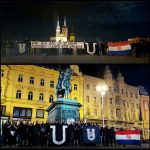Touring exhibition on Anne Frank in a school in Šibenik was closed after school principal objected to some of the exhibits.
The exhibition “Anne Frank – a History for Today”, which was recently opened at the Technical School in Šibenik, was unexpectedly closed the same day after school principal Josip Belamarić criticized it for presenting Yugoslav Partisans in a positive light, unlike the Ustasha who were portrayed as criminals who slaughtered Jews and starving children. He demanded that controversial exhibition panels should be removed. The organizers of the exhibition, the association Croatian Educational and Development Network for Evolution of Communication (HERMES), decided to withdraw the entire exhibition from the school, reports Nacional on January 21, 2017.
The exhibition was part of an international project for the education of young people and will be presented in forty countries. The presentation in Šibenik was a result of cooperation between HERMES and the Anne Frank House association from Amsterdam. Depending on the country and the town in which it is presented, the exhibition also includes local content related to the theme of the exhibition. That was the reason why the exhibition in Šibenik added panels about the Ustasha and the Partisans.
“The problem was that the organizers wanted to, in addition to 30 panels related to Anne Frank, add six more panels which are not part of European exhibition and which depict the Ustasha and the Partisans. According to these panels, the Ustasha were criminals who slaughtered Serbs and Jews and starved children, while the Partisans never did anything wrong. What about the crimes committed by the partisans? Why did they not show how the Partisans killed Croats after World War II?” said principal Belamarić who asked the organizers to remove the six panels.
Tvrtko Pater, a project coordinator for HERMES, said that there was a misunderstanding with the principal. “Šibenik was the 24th town in which the exhibition was presented. We tell everyone in advance that there is a European part of the exhibition, but also a part which presents local history. The principal was obviously not aware of the second, Croatian part of the exhibition”, said Pater. He added that the exhibition itself would be nothing without context and therefore, in each school which they visit, members of the association spend two days training students who will act as exhibition guides for others.
“The exhibition without context is just a bunch of static panels and does not function without the guidance of students, so we understand what it could have looked like to the principal. We cannot put everything on panels, and we even offered to school to create additional panels that would display parts of history that the principal thought were missing, but they refused and we unfortunately had to withdraw the entire exhibition”, said Pater.
Šibenik thus became the first town from which the exhibition was withdrawn. There were problems in other towns as well, but they all were successfully resolved. “We had a problem in the Republika Srpska in Bosnia and Herzegovina where they criticized us since we did not mention that Serbs refused to participate in a referendum on independence of Bosnia and Herzegovina. We solved the problem by adding more panels”, said Pater.
The opening of the exhibition in Šibenik was attended by Šibenin-Knin County Prefect Goran Pauk, who said at the time that he was glad that Šibenik hosted an international exhibition which should encourage high school students to critically evaluate historical facts and current events. “I was invited to the opening of the exhibition and I liked it, especially since this is a topic which will be always important. I have not seen anything objectionable, but I do not have other information so I cannot give further comment”, said Pauk.
The exhibition, which was opened in Šibenik just one day, will now move to Našice, and organizers hope to return to Šibenik next year. They plan to put the exhibition in a different school or in the local Antifascism Museum.








